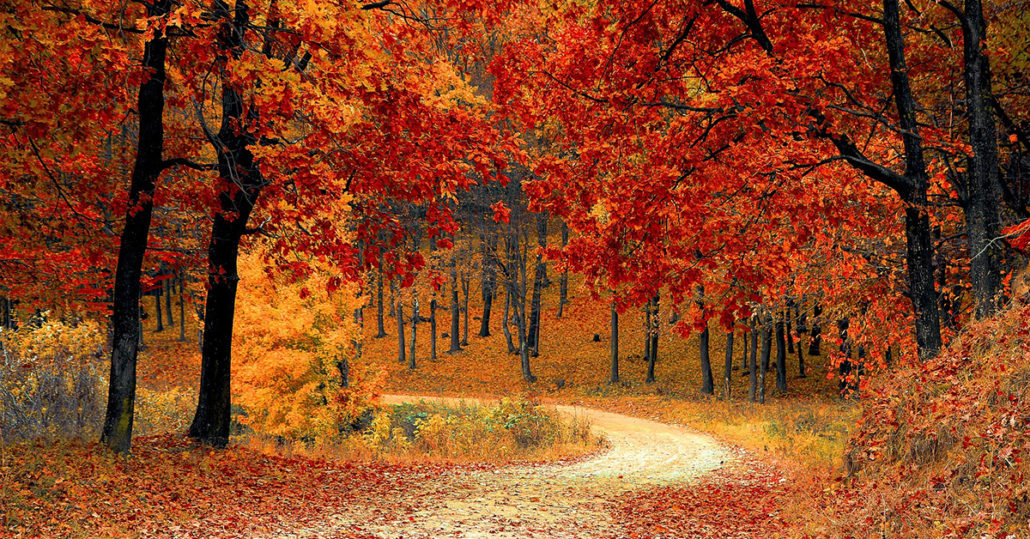Written by Glenn Morris and published on https://www.farmersalmanac.com/.
On the first day of fall, it’s only appropriate that we write about spectacular autumn foliage. More specifically, we thought it would be good to discuss why leaves change color this time of year. Let’s revisit your middle school science class for a moment. According to ScienceDaily, chlorophyll is a green pigment found in plants, algae, and cyanobacteria. You might remember that chlorophyll plays an essential role in the process of photosynthesis, which allows plants to absorb energy from light.
So how does chlorophyll factor into the changing of leaves? Well, as summer comes to a close and temperatures start to become more fall-like, the chlorophyll in the leaves begins to break down. This is when we see the various color pigments, including red, orange, and yellow. Interestingly, the colors are most vibrant when the end of summer is dry, and the beginning of autumn consists of bright sunny days and cool nights.
Table of Contents
What Causes Leaves To Change Color?
Ever wonder why leaves change color each fall?
We checked in with a real “fall guy,” Appalachian State University Biology professor, Howard Neufeld, who has been studying fall color for much of his career, to get the answer. His scientific interest in what occurs inside a leaf has naturally progressed to what shows outside, and when. Neufeld‘s research and sociability have made him a go-to guy for fall color science and forecasting. So what does he say about why leaves change color?
What Signals A Leaf To Change Color?
The vivid, often simple colors on the outside are the products of the complex chemistry of growth inside a leaf. Take the yellows and oranges, for example—the dominant colors of aspen, ash, birch, beech, hickories, maples, some oaks, tulip poplar, and sassafras—generally, these colors come from compounds called carotenoids (also responsible for the color of carrots) which are present in the leaf during the growing season.
The green chlorophyll, the workhorse of photosynthesis, dominates and covers up those carotenoids in summer. As the days grow shorter and the temperatures cool, chlorophyll degrades and goes from green to colorless, allowing the oranges and the yellows to show up. These colors are present in the leaf during its growing season.
What About The Reds – How Does That Happen?
Those gorgeous scarlet, crimson, and ruby hues of the red maples, black gums, dogwoods, sourwood, and oaks are what makes fall the most breathtaking. “Red pigments are not present in the leaf during summer,” Neufeld says. “Trees that turn red actually produce this pigment, called anthocyanin, in the autumn.” However, though we might like to think so, plants don’t make this red pigment for our appreciation. These pigments play a key role in readying the tree for the next spring. Researchers discovered that anthocyanins act as a sunscreen, protecting leaves (especially evergreen ones) from bright seasonal light when it is cold outside. Other researchers have discovered that the sunscreening effect protects leaves from too much light, which can interfere with late-season transport of nutrients from the leaf back to the twigs, something trees do as a conservation mechanism.
Still, other scientists believe the red color serves to ward off insect pests. A healthy, strong plant has lots of anthocyanins; certain insects laying eggs in the fall may seek other, weaker host plants for their offspring.
While anthocyanins may ward off insects, there is no doubt that they are magnets for “leaf peepers” for fall color tourism. A little bit of red goes a long way—and more is even better.
What Conditions Make For Good Fall Color?
Neufeld offers a “recipe” for good autumn color: “Starting in August, days must be sunny and the nights steadily cooling. This allows the trees to manufacture sugars, and sugars stimulate the leaves to make anthocyanins. The cold helps keep the sugars in the leaves producing anthocyanins.”
The calendar needs an August footnote to remind us to watch the weather during that month for fall color later. Too many clouds, too much rain, or too much heat in the eighth month can make for a duller fall. September, though generally cooler, follows suit. “Drought is the other enemy of a good fall.” Neufeld adds, “The trees have to be in a healthy state —not water-stressed—heading into the season.”
Neufeld does his best to provide such guidance with continuous observation. The good news for would-be travelers is that “peak color” is a peculiarly local condition depending on the local weather, the mix of trees, the elevation above sea level, and the distance from the equator.
When Do Leaves Change?
Fall color starts earlier at higher altitudes and in northern regions than it does in lower elevations or farther south. Apply these rules to a map of North America and it is possible to zigzag north to south, higher to a lower altitude to extend fall color viewing for nearly six weeks, maybe longer. Fall color is about location, location, location—and good timing!
What About Trees Down South—Do They Change Color?
Where palm trees, live oaks, and cactus grow, there is little to “rake home about” in autumn. The Gulf Coast and the arid southwest are mostly fall-colorless.
What Can I Plant For Fall Color?
Want a burst of color each fall? Consider planting these small trees with reliable fall color:
Red – Flowering Dogwood
Yellow – Redbud
Orange/Crimsom – Japanese Maple
Excellent fall color featured in large trees includes October Glory red maple (uniformly red), sugar maple (orange), and katsura (yellow).
Original post here https://www.farmersalmanac.com/chemistry-fall-color-19160.


